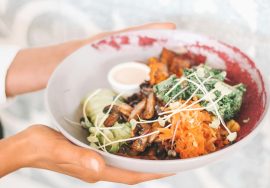
Comfort Without Compromise: Guilt-Free Swaps for Classic Comfort Foods
There’s something magical about comfort food. It’s the grilled cheese that warms you up on a rainy day, the bowl of mac and cheese that takes you back to childhood, or the decadent dessert that soothes your soul after a long week. These dishes are more than just meals—they’re emotional anchors. But for those trying to eat healthier, comfort food often feels like the enemy. Full of saturated fats, processed sugars, and simple carbs, these favorites can clash with nutrition goals.
The good news? You don’t have to give them up.
With a little creativity and a willingness to experiment, it’s possible to reinvent your favorite comfort foods using healthier ingredients that retain the taste and satisfaction you crave. From using vegetables in surprising ways to choosing smarter fats and grains, these guilt-free swaps let you enjoy indulgence with zero regret. This essay explores how small changes in traditional recipes can lead to big wins for your health—without sacrificing flavor, tradition, or joy.
Why Comfort Foods Are So Hard to Resist
Before diving into healthier alternatives, it’s worth understanding why comfort foods are so appealing. Psychologists link them to nostalgia and emotional well-being. We reach for creamy pastas or crispy fried foods not just for their taste but because they evoke safety, warmth, or even celebration.
Unfortunately, these feel-good dishes tend to be heavy on calories, sodium, and refined ingredients. Over time, indulging regularly can lead to sluggishness, weight gain, and other health issues.
That’s why healthy swaps aren’t about denial—they’re about preserving the comfort while upgrading the food.
- Mac and Cheese: Cauliflower Power
Traditional mac and cheese is a double whammy of white pasta and creamy, buttery cheese sauce. A healthier take can be just as rich with a few thoughtful swaps.
The Swap:
Use whole-grain or chickpea pasta instead of white pasta for added fiber and protein.
Blend steamed cauliflower with a bit of Greek yogurt, garlic, nutritional yeast, and low-fat cheese to create a creamy “cheese” sauce that’s lower in fat but big on flavor.
Why It Works:
Cauliflower’s mild taste makes it the perfect base for a velvety sauce. You still get the creamy texture but with fewer calories and more nutrients.
- Pizza: Veggie-Based Crusts and Smart Toppings
Pizza is a comfort food icon—but the thick crust, processed meats, and gooey cheese can make it a nutritional landmine.
The Swap:
Use a cauliflower or whole-wheat crust instead of white flour dough.
Top with veggies like bell peppers, mushrooms, spinach, and lean proteins such as grilled chicken or turkey sausage.
Swap heavy cheese for part-skim mozzarella or go light with a sprinkle of feta.
Why It Works:
You don’t lose the pizza experience, but you gain fiber, reduce unhealthy fats, and up your intake of vitamins and minerals.
- Fried Chicken: Oven-Baked Crunch
Golden, crispy fried chicken is a Southern classic, but the deep-frying adds a lot of saturated fat and calories.
The Swap:
Coat chicken pieces in whole-wheat breadcrumbs or crushed cornflakes seasoned with paprika, garlic powder, and black pepper.
Bake or air-fry instead of deep frying.
Why It Works:
You get the same crispy outside and juicy inside—without the grease. Air fryers in particular have revolutionized healthy cooking, offering a guilt-free way to enjoy fried favorites.
- Mashed Potatoes: Cauliflower and Greek Yogurt Remix
Creamy mashed potatoes are a holiday table staple, but loads of butter and cream can make them heavy.
The Swap:
Mix mashed potatoes with steamed cauliflower to cut calories and carbs.
Use Greek yogurt instead of butter or cream for a tangy, creamy boost.
Why It Works:
Cauliflower adds fiber and nutrients without drastically changing the texture, while Greek yogurt adds creaminess with fewer calories and more protein.
- Ice Cream: Frozen Banana “Nice Cream”
Who doesn’t love a scoop of ice cream? Unfortunately, most store-bought versions are loaded with added sugars and artificial ingredients.
The Swap:
Freeze ripe bananas, then blend them until smooth for a naturally sweet and creamy dessert.
Add cocoa powder, peanut butter, or berries for flavor variety.
Why It Works:
Bananas provide natural sweetness, and the texture mimics soft-serve ice cream. You can indulge your sweet tooth while getting fiber and potassium.
- Tacos: Lettuce Wraps and Lean Proteins
Tacos are endlessly customizable, but traditional versions with fried shells, fatty meats, and heavy toppings can sneak in a lot of unnecessary calories.
The Swap:
Use lettuce leaves or grilled portobello mushrooms as taco “shells.”
Replace ground beef with ground turkey, lentils, or black beans.
Top with salsa, avocado, and Greek yogurt instead of sour cream.
Why It Works:
You keep the flavor and crunch but shed the excess fat and carbs. It’s still satisfying, colorful, and festive—but much lighter.
- Pasta Dishes: Zoodles and Legume-Based Pasta
Creamy Alfredo and rich Bolognese sauces over refined noodles are comforting but carb-heavy.
The Swap:
Use spiralized zucchini (zoodles) or spaghetti squash in place of pasta.
Opt for lentil or chickpea pasta for more protein and fiber.
Why It Works:
You’ll still get the satisfaction of twirling noodles around your fork, but with fewer carbs and more nutritional value.
- Brownies: Black Beans or Avocados for the Win
Baked goods are tough to give up—but they’re often packed with sugar, butter, and refined flour.
The Swap:
Use puréed black beans or mashed avocado in place of some of the flour and fat.
Sweeten with maple syrup or mashed bananas.
Why It Works:
The texture remains fudgy, and the flavor stays rich—plus you add fiber, healthy fats, and protein.
- Burgers: Better Buns and Patties
Burgers don’t have to be banished from a healthy lifestyle. It’s all about building a better burger.
The Swap:
Use whole-grain buns or lettuce wraps.
Swap beef for turkey, salmon, veggie, or black bean patties.
Load up on fresh veggies and mustard instead of mayo and cheese.
Why It Works:
You still satisfy that burger craving, but with fewer calories and more wholesome ingredients.
- Grilled Cheese: Smarter Bread and Cheese Choices
Simple and nostalgic, the grilled cheese sandwich is a classic comfort food. But it’s often high in saturated fat and low in fiber.
The Swap:
Use whole-grain or sprouted bread.
Swap in a reduced-fat cheese or try combining a smaller amount of sharp cheddar (for flavor) with low-fat mozzarella (for meltiness).
Add veggies like tomato, spinach, or avocado for an extra nutrient kick.
Why It Works:
You retain the comfort of a warm, gooey sandwich while introducing balance and better nutrition.
The Psychology of Healthy Swaps
An important aspect of healthy eating is mindset. If you approach healthy swaps as “less than,” you may feel deprived. But when you see them as upgrades—ways to nourish yourself while still enjoying life—something shifts. The focus becomes about feeling good, not just looking good.
Many of these swaps also invite creativity into your kitchen. You may discover new flavor combinations, develop cooking skills, and even enjoy food more because of the mindfulness it promotes.
Final Thoughts: Comfort Food Without Compromise
The beauty of comfort food lies not just in its taste, but in how it makes you feel. With the right swaps, you don’t have to choose between health and happiness—you can have both. By reimagining your favorite dishes with smart, nutritious ingredients, you allow yourself the joy of indulgence while supporting your well-being.










